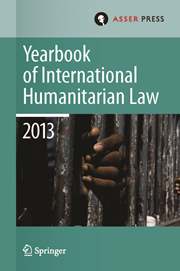Article contents
THE APPLICATION OF IHL IN THE GOLDSTONE REPORT: A CRITICAL COMMENTARY*
Published online by Cambridge University Press: 02 November 2010
Abstract
Operation Cast Lead, the Israeli military operation in Gaza that began on December 27, 2008, demonstrated anew the challenges international humanitarian law faces in contemporary conflict. The Goldstone Report presented an opportunity to examine critically how the law applies in complicated modern warfare and how the law might be used to solve difficult problems such conflict poses.
This article analyzes the Goldstone Report's application of the law to the conduct of both parties in the conflict to examine how it applies and interprets the legal standards within the framework of the Gaza conflict. In particular, the article focuses on two main shortcomings in the Goldstone Report's application of IHL: areas in which the report could have benefitted from a greater sensitivity to the complexities of modern warfare, and areas in which its approach is questionable as a matter of law.
First, the article highlights the report's flawed examination of the challenges posed by contemporary conflicts in two fundamental areas of IHL: distinction and military objectives. Both require that military commanders and soldiers understand who is a civilian and who is a fighter or combatant, and which targets are military targets and which are civilian objects. Without a thorough and sophisticated understanding of how to make these determinations, military commanders, soldiers and policy makers will face grave difficulty in planning and carrying out military operations within the bounds of the law. The challenges presented in Operation Cast Lead are emblematic of some of the most difficult dilemmas modern warfare poses.
Second, the article highlights several areas in which the Goldstone Report's application of IHL is questionable, either because it uses the incorrect legal standard or because it applies the wrong law when more than one body of law applies. The report errs twice in its treatment of the principle of proportionality, first by approaching jus in bello proportionality retrospectively rather than prospectively, and second by conflating jus ad bellum proportionality with jus in bello proportionality. Additional problems arise in its analysis of the law governing precautions in attack and the treatment of prisoners of war, and its assessment of responsibility for specific crimes, including attacks on civilians, destruction of property and hostage taking.
Keywords
- Type
- Current Developments
- Information
- Copyright
- Copyright © T.M.C. Asser Instituut and the Authors 2009
References
* © L.R. Blank, 2010.
- 9
- Cited by


